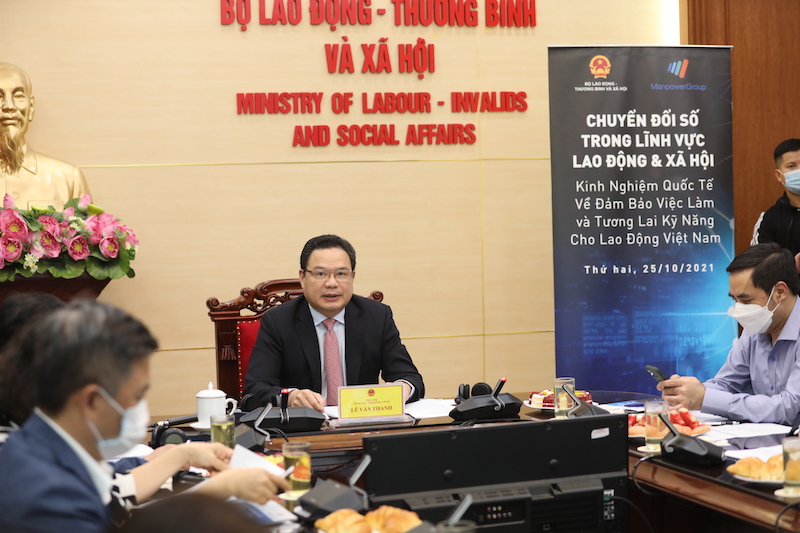Digital transformation to flourish employment sustainability in Vietnam
Local and foreign human resources experts said that people’s wellbeing should be among the top priorities during the pandemic.
Vietnam’s labor market is expected to recover from 2020, however, the unpredictable pandemic has required the sector to take cautious steps and digitalize its operation to adapt to the new normalcy, said Le Van Thanh, Deputy Minister of the Ministry of Labor, Invalids and Social Affairs (MoLISA).
Thanh was speaking at the webinar “Digital Transformation: International Experience in Employment Security & the Future of Skills for Vietnamese Workers” on October 25, giving his view on the impacts of the global health crisis and digital transformation on national employment.
| Le Van Thanh, Deputy Minister of the Ministry of Labor, Invalids and Social Affairs at the webinar. Photos: ManpowerGroup Vietnam |
Thanh and delegates discussed international experiences of digital transformation and the new in-demand skills, as well as solutions to sustainable employment and the future of skills for local workers.
As digital transformation is among today’s workforce trends, the Skills Revolution Reboot 2021 research released by ManpowerGroup reveals 38% of companies globally are speeding up their digitization and automation.
Vietnam is catching up with the trend with up to 94% of foreign-invested enterprises devising clear directions in enhancing the application of new technologies in manufacturing activities in the coming three years, according to the recent survey by ManpowerGroup Vietnam with the MoLISA’s Institute of Labor and Social Affairs.
“Under the impact of the industrial revolution 4.0 and the pandemic, employers today take a more important role than ever in providing sustainable employment, and the HR department should consider adopting the people-first approach in their business strategy,” said Simon Matthews, Regional Manager of ManpowerGroup Vietnam, Thailand & Middle East.
As per ManpowerGroup research’s findings, the top priorities of human resource professionals today include employee’s health and wellbeing (63%), new work models (37%), and more upskilling, learning, and development for the employees (30%).
Jonas Prising, CEO and Chairman of ManpowerGroup said: “Now is the time to reshape a better, brighter future for workers - one that is more skilled, more diverse, and more wellbeing-orientated than we could ever have imagined.”
Vu Trong Binh, Director General of the MoLISA's Department of Employment told The Hanoi Times about the latest plan and support for local businesses to improve workforce skills towards Industry 4.0 in Vietnam at a relevant webinar on October 25.
What plan has the MoLISA built in relation to investment in upskilling and reskilling the workforce towards Industry 4.0 and integrating technology in new model development? This is a difficult question. Currently, we are building forecasts for the 5-year strategy on the trend of job restructuring by region, industry, quality, employment under new production, and business models. It is seen as a difficult task but we hope to receive the support of stakeholders to predict and assess how the employment structure in all aspects will change. Based on this employment restructuring strategy, Vietnam will determine the training and quality improvement of the workforce. Our current point of view is to train a national-level and unified workforce and connect internationally. The most important thing is to create mechanisms and policies to ensure the attraction of resources, in which training institutions will actively provide resources for the market, and a high-quality labor force returning to Vietnam. What sectors will benefit from the national skill enhancement program in the digital technology era? As I mentioned above, the country has not yet had an employment strategy, so there is no synchronous policy to promote activities related to such support. The support to train new skills for workers focuses on the disadvantaged and self-employed persons. Meanwhile, policies to support those who work in the high-tech sector and 4.0 technology or who are at risk have begun to take shape. Therefore, our point of view when designing the upcoming job restructuring strategy is to form a connection between supply and demand so that the labor market can self-regulate training. The State will take the role of leadership, informing and providing information for both sides. We will try our best in the coming time to ensure that training institutions and employers can identify the needs of the market to deal with. What kinds of financial support will local enterprises, who invest in upskilling workers, receive to embark on high technology application and digitalization? Digital transformation depends on the needs of enterprises themselves to adapt to the digitalization trend. Currently, the State is expected to build a national digital infrastructure as a basis on which businesses can successfully deploy digital transformation. Without this digital infrastructure, businesses cannot strongly operate in the digital business environment. We have launched a national employment co-operative fund and working on a job restoration program. As you know, small-medium enterprises have many ways to access credit sources, but still, need the support of the state. In fact, the investment for the digital economy requires high costs to succeed. Thank you for your time! |











